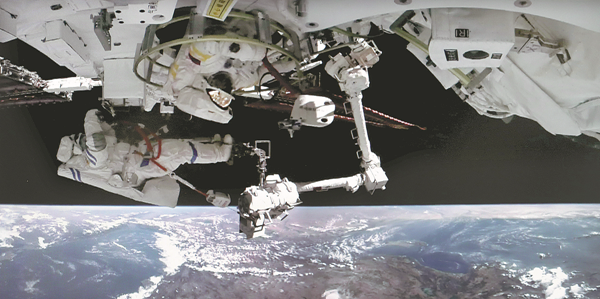Duo undertake 7-hour spacewalk

China's Shenzhou XIV astronauts Chen Dong (right) and Liu Yang exit the space station lab module Wentian on Thursday, and use a robotic arm to install new instruments outside the Tiangong space station. This photo has been inverted top to bottom. XU BU/FOR CHINA DAILY
Astronauts use Wentian lab's airlock cabin for first time on 88th day in space
Chinese astronauts on the Shenzhou XIV mission have started carrying out their first spacewalk, also known as an extravehicular activity, which is scheduled to finish early on Friday morning, according to the China Manned Space Agency.
Mission commander Senior Colonel Chen Dong opened an extravehicular activity hatch on the Tiangong space station at 6:26 pm on Thursday Beijing time and then floated out of the station. He was followed by female crew member Senior Colonel Liu Yang, the agency said in a news release.
It was the first spacewalk ever conducted by Chen and Liu, both of whom are on their second space journey.
The other team member-Senior Colonel Cai Xuzhe-stayed inside the station to support their operations, the release said.
Chen and Liu were tasked with using a robotic arm to install new instruments outside Tiangong, adjusting the panoramic camera and other operations. The two were scheduled to stay outside for around seven hours, according to the agency.
It was the first time that astronauts have used the Wentian space lab's airlock cabin to make preparations for and then carry out a spacewalk.
Crew members of previous flights used the airlock cabin on the Tianhe core module to support spacewalks.
With the new cabin, the one on Tianhe has become the backup support facility for future spacewalks.
Zhang Qiao, head designer of Wentian's overall structure at the China Academy of Space Technology, said the new cabin's inner space is bigger than that of the Tianhe module, and its hatch is wider, and these make it easier for astronauts to prepare themselves and carry out spacewalks.
The spacewalk also marks the first time that a new type of tether line and a new external lighting system have been used on the Chinese space station.
Pang Zhihao, a renowned observer of China's manned spaceflights, said astronauts would verify whether the new airlock cabin works well to support spacewalks.
"It must be more comfortable and convenient for astronauts to use the new cabin for their spacewalk because the section was specifically designed to support extravehicular activities," he said.
"As soon as the astronauts opened the hatch, they must have seen the beautiful scenes of the mother planet, as the hatch is always directed toward the Earth," Pang said.
Pang, who was a senior researcher at the China Academy of Space Technology, said the spacewalk was also intended to demonstrate the capabilities of the robotic arm on the Wentian lab.
Chen and his teammates had spent 88 days in orbit as of Thursday and have conducted a series of tasks such as arranging cargo, testing equipment and conducting scientific experiments, the space agency said.
The crew arrived at Tiangong on the evening of June 5, several hours after their spacecraft was launched from the Jiuquan Satellite Launch Center in the northwestern Gobi Desert.
They are scheduled to stay at the station, orbiting 400 kilometers above Earth, for six months to monitor the planned assembly of the colossal outpost.
Shenzhou XIV is the sixth spacecraft to visit Tiangong and the third crewed ship to transport astronauts to the station.
Currently, Tiangong consists of the Tianhe core module, the Tianzhou 4 cargo ship, the Shenzhou XIV spacecraft and the Wentian space lab, which was launched in late July.
Mission planners said Tiangong's second lab component, Mengtian, will be lifted by a Long March 5B carrier rocket from the Wenchang Space Launch Center in Hainan province in October.
After Mengtian is connected with Tiangong, the station will be a T-shaped structure. The entire station is expected to work in orbit for 15 years.